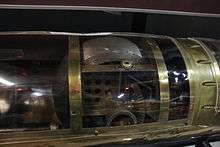Howell torpedo
| Howell torpedo | |
|---|---|
|
Howell torpedo at the Naval War College Museum in Newport, Rhode Island | |
| Type | Anti-surface ship torpedo[1] |
| Place of origin |
|
| Service history | |
| In service | 1890–1898[2] |
| Used by |
|
| Production history | |
| Designer | John A. Howell[2] |
| Designed | 1870[2] |
| Manufacturer | Hotchkiss Ordnance Company[2] |
| Produced | 1889[2] |
| Number built | 50 units[2] |
| Specifications | |
| Weight | 580 lbs[2] |
| Length | 132 inches[2] |
| Diameter | 14.2 inches[2] |
|
| |
| Effective firing range | 400 yards[2] |
| Warhead | wet guncotton[2] |
| Warhead weight | 100 lbs[2] |
Detonation mechanism | Contact device |
|
| |
| Engine | Flywheel[2] |
| Speed | 25 knots[2] |
Launch platform | Battleships and torpedo boats[1] |
The Howell Automobile Torpedo was the first self-propelled torpedo produced in quantity by the United States Navy, which referred to it as the Howell Mark I torpedo.[1] It was conceived by Lieutenant Commander John A. Howell, United States Navy, in 1870, using a 60 kg (130 lb) flywheel spun at a very high speed (10000 to 12000 rpm) to store energy and drive propellers.
Design

Because it had no complicated engine and fuel system, the Howell was much cheaper and easier to build than its main competitor, the Whitehead. In addition, unlike the Whitehead, the Howell was wakeless, not giving away the position of the firing vessel; its flywheel was, however, very noisy. It did demand a steam turbine to "spin up" the flywheel (a complication inherent to the design). Also unlike the contemporary Whitehead, the Howell kept running in a straight line, due to the gyroscopic effect of the flywheel. A wave coming from one side would tend to roll the Howell rather than deviate it. The roll was easily corrected by the rudders. Depth control was regulated by a pendulum as in the 'secret' pioneered by Robert Whitehead. The Howell was the first torpedo to use the gyroscope effect, which Howell patented. When, in an attempt to improve directional stability, Whitehead (using a Ludwig Obry design) adopted the gyroscope in 1895, Howell sued for patent infringement.
Production


After very protracted development – the product of a paucity of funds, the novelty of the torpedo as a weapon, and myopia of the Navy's senior officers – fifty Howell Torpedoes Mark 1 were ordered (from Hotchkiss Ordnance Company of Providence, Rhode Island) in 1889. This was 14.2 in (36 cm) diameter, 129.75 in (330 cm) long, with a 96 lb (43.5 kg) warhead and a range of 400 yd (365 m) at 25 knots (46 km/h). Contemporary Whiteheads, built by E. W. Bliss Company, had superior performance, and greater growth capacity.
These fifty would be the only production examples, as the Howell was superseded by a rapidly improving Whitehead in 1892; as a consequence, the Howell's drawbacks were never cured. It is, therefore, impossible to know if quieting would have mitigated any loss of surprise to noise (as sometimes suggested).
A contemporary account of an operational test carried out on a Howell torpedo described its performance, where it "ran along the surface at a very fast but very regular speed for four minutes" and that there was "no horizontal deviation and the run was fully 900 yards".[3]
Surviving examples


In May 2013, a Howell torpedo was discovered in two pieces on the seabed by US Navy-trained dolphins, near Coronado, California.[4][5] Prior to this discovery, only two Howell torpedoes were known to exist: one at the Naval Undersea Museum and the other at the Naval War College Museum in Newport R.I.[6]
See also
External links
- History of the Howell Torpedo from the U.S. Navy.
- Howell Torpedo Display at the US Naval Undersea Museum
- Animation of Howell Torpedo 1896
Sources
- Blair, Clay. Silent Victory. Philadelphia: Lippincott, 1975
- Fitzsimons, Bernard, general editor. "Howell", in The Encyclopedia of Twentieth Century Weapons and Warfare. London: Phoebus/BBC, 1978. Volume 13, page 1371.
- "Howell torpedo", in The Columbia Encyclopedia, Sixth Edition, online
- Kirby, Geoff. "A History of the Torpedo The Early Days", in The Journal of the Royal Navy Scientific Service, Vol 27 No 1.
- Milford, Frederick J. "US Navy Torpedoes--Part One: Torpedoes through the thirties", in The Submarine Review, April 1996. (a quarterly publication of the Naval Submarine League, P.O. Box 1146, Annandale, VA 22003)
References
- 1 2 3 The Howell Torpedo, U.S. Navy, 14.2 inches, Mark I, General Description. United States Navy. 1 September 1896.
- ↑ "Fired A Howell Torpedo". The New York Times. 1894-10-24. Retrieved 2013-05-27.
- ↑ "State-of-the-art 19th-century torpedo was discovered by Navy dolphins". Los Angeles Times. Retrieved 2013-05-19.
- ↑ "Navy dolphin finds 130-year-old torpedo". Fox News. Retrieved 2013-05-21.
- ↑ Gamboa, Elisha. "SSC Pacific recovers Historic Howell Torpedo". Navy News Service. Retrieved 25 May 2013.
